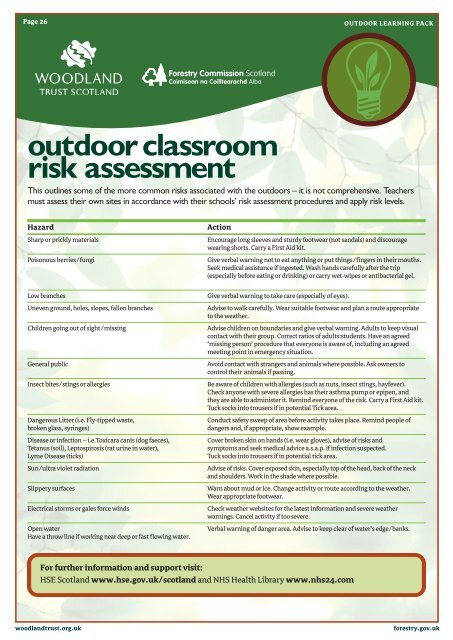2nSbdOqrV
2nSbdOqrV
2nSbdOqrV
You also want an ePaper? Increase the reach of your titles
YUMPU automatically turns print PDFs into web optimized ePapers that Google loves.
Page 126OUTDOOR LEARNING PACKoutdoor classroomrisk assessmentThis outlines some of the more common risks associated with the outdoors – it is not comprehensive. Teachersmust assess their own sites in accordance with their schools’ risk assessment procedures and apply risk levels.HazardSharp or prickly materialsPoisonous berries/fungiLow branchesUneven ground, holes, slopes, fallen branchesChildren going out of sight/missingGeneral publicInsect bites/stings or allergiesDangerous Litter (i.e. Fly-tipped waste,broken glass, syringes)Disease or infection – i.e.Toxicara canis (dog faeces),Tetanus (soil), Leptospirosis (rat urine in water),Lyme Disease (ticks)Sun/ultra violet radiationSlippery surfacesElectrical storms or gales force windsOpen waterHave a throw line if working near deep or fast flowing water.ActionEncourage long sleeves and sturdy footwear (not sandals) and discouragewearing shorts. Carry a First Aid kit.Give verbal warning not to eat anything or put things/fingers in their mouths.Seek medical assistance if ingested. Wash hands carefully after the trip(especially before eating or drinking) or carry wet-wipes or antibacterial gel.Give verbal warning to take care (especially of eyes).Advise to walk carefully. Wear suitable footwear and plan a route appropriateto the weather.Advise children on boundaries and give verbal warning. Adults to keep visualcontact with their group. Correct ratios of adults:students. Have an agreed‘missing person’ procedure that everyone is aware of, including an agreedmeeting point in emergency situation.Avoid contact with strangers and animals where possible. Ask owners tocontrol their animals if passing.Be aware of children with allergies (such as nuts, insect stings, hayfever).Check anyone with severe allergies has their asthma pump or epipen, andthey are able to administer it. Remind everyone of the risk. Carry a First Aid kit.Tuck socks into trousers if in potential Tick area.Conduct safety sweep of area before activity takes place. Remind people ofdangers and, if appropriate, show example.Cover broken skin on hands (i.e. wear gloves), advise of risks andsymptoms and seek medical advice a.s.a.p. if infection suspected.Tuck socks into trousers if in potential tick area.Advise of risks. Cover exposed skin, especially top of the head, back of the neckand shoulders. Work in the shade where possible.Warn about mud or ice. Change activity or route according to the weather.Wear appropriate footwear.Check weather websites for the latest information and severe weatherwarnings. Cancel activity if too severe.Verbal warning of danger area. Advise to keep clear of water’s edge/banks.For further information and support visit:HSE Scotland www.hse.gov.uk/scotland and NHS Health Library www.nhs24.comwoodlandtrust.org.ukforestry.gov.uk


